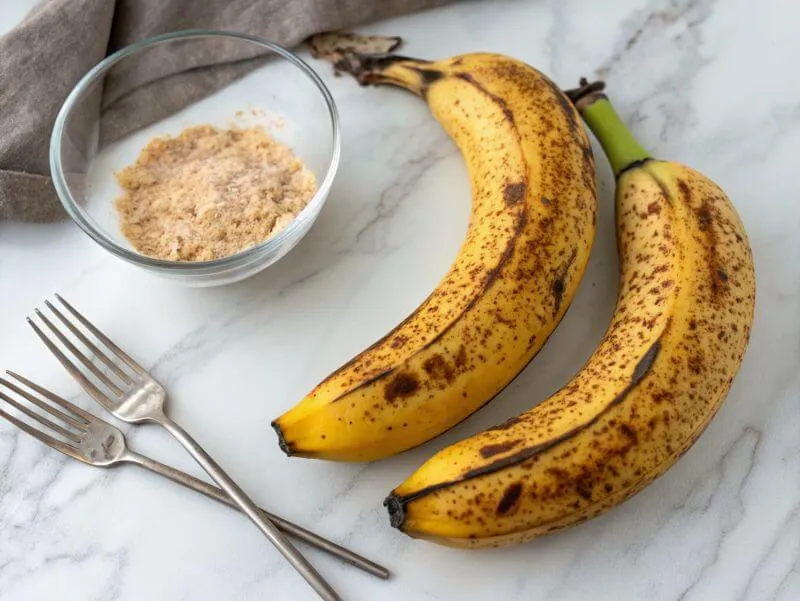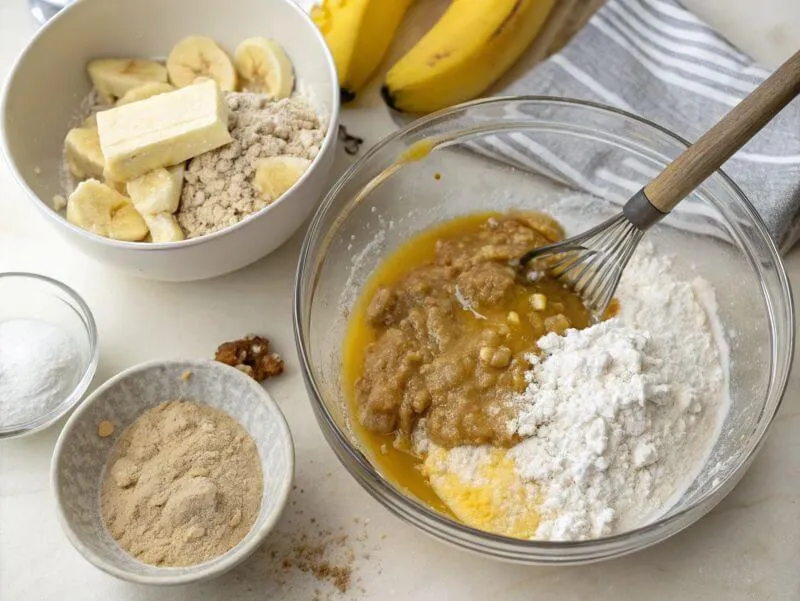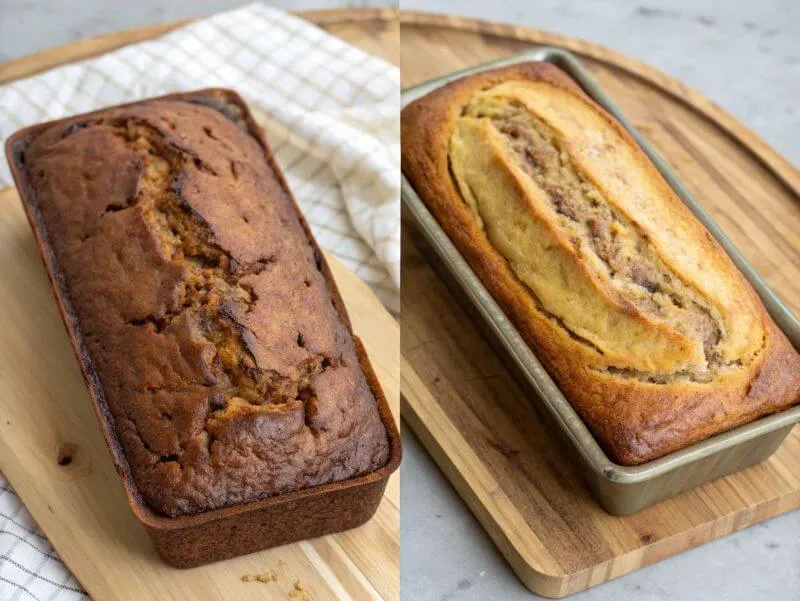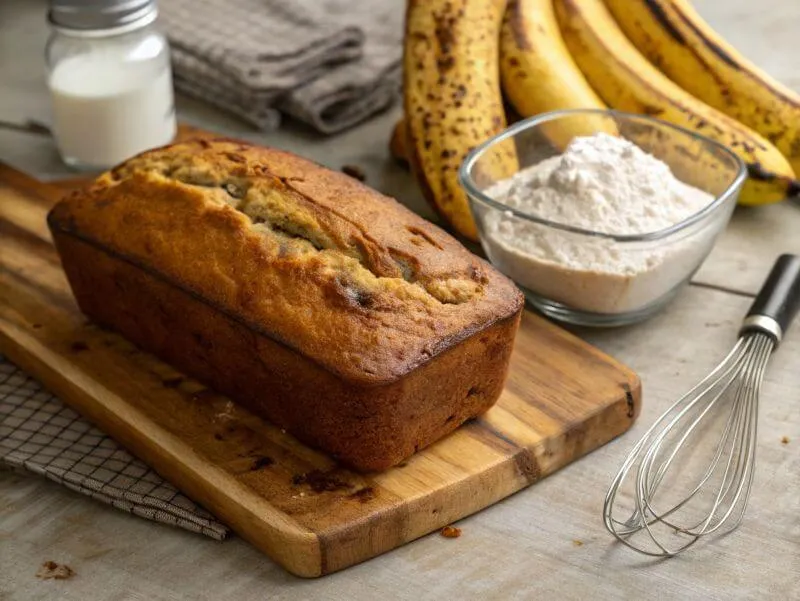Introduction
What is the number one mistake made when making banana bread? Banana bread is a timeless classic that has been a favorite in kitchens worldwide. It’s comforting, delicious, and incredibly versatile. But let’s be honest—baking banana bread isn’t always foolproof. Many bakers, from beginners to seasoned pros, make simple errors that can turn this delightful treat into a dense, dry, or lackluster loaf.
This article tackles the question, “What is the number one mistake made when making banana bread?” and dives deep into why it matters. From using the wrong bananas to overmixing the batter, you’ll learn to avoid the pitfalls that can ruin your banana bread. By the end, you’ll be armed with tips, tricks, and the science behind crafting the perfect loaf every time.
Why Banana Bread is a Popular Choice for Bakers
Why We Love Banana Bread
Banana bread has earned its spot as a beloved baked good. It’s easy to make, forgiving for beginners, and a fantastic way to use up overripe bananas that might otherwise go to waste. Its moist texture and sweet flavor make it a crowd-pleaser for any occasion, from breakfast to dessert. Plus, it’s endlessly customizable—you can add nuts, chocolate chips, or even spices like cinnamon to create your signature version.
But even though banana bread seems simple, getting it just right can be a challenge. Have you ever wondered why your loaf turned out dense instead of fluffy? Or why the edges were overbaked while the middle remained raw? These issues often stem from common mistakes, including the one we’ll focus on in this article.
Why Avoiding Mistakes is Crucial
Banana bread might seem easy, but baking is a science. Minor missteps, like using too firm bananas or overmixing the batter, can lead to disappointing results. Learning the number one mistake made when making banana bread and how to avoid it can elevate your baking skills and create consistently delicious loaves.
This article uncovers the top mistakes and highlights other common errors, offering practical advice to help you bake like a pro. Whether you’re a first-time baker or a seasoned expert, understanding the do’s and don’ts will ensure your banana bread turns out perfect every time.
The Number One Mistake: Using the Wrong Bananas

Why Overripe Bananas Are Essential for Banana Bread
When baking banana bread, the bananas you use can make or break the recipe. So, what is the number one mistake made when making banana bread? Using the wrong type of bananas tops the list. Many people grab firm, yellow bananas straight from the fruit bowl, thinking they’re perfect for baking. But here’s the thing—those bananas aren’t ready yet.
Overripe bananas, with brown spots or even completely black peels, are the secret to moist and flavorful banana bread. Their natural sweetness intensifies as they ripen, giving your bread that rich, caramelized flavor we all love. Plus, overripe bananas mash more easily, creating a smoother texture in the batter. Your banana bread could be bland, dry, or even harsh without them.
How Using the Wrong Bananas Affects Texture and Flavor
Using under-ripe bananas leads to two common problems: lack of flavor and improper texture. Firm bananas don’t break down well during mixing, leaving chunks in your batter that don’t blend evenly. This can result in a loaf with an uneven texture and pockets of banana that don’t bake properly.
Flavor is another big issue. Under-ripe bananas are starchy and less sweet, so your bread won’t taste that deep, banana-forward. Always opt for overripe, soft, and fragrant bananas to fix this. If you don’t have any ripe bananas on hand, a quick hack is to bake them in the oven at 300°F for about 15-20 minutes until the skins turn black. This mimics the ripening process and brings out their sweetness.
Now that you know the number one mistake, let’s dive into other common errors in Part 3.
Other Common Mistakes in Banana Bread Baking
Overmixing the Batter and Its Impact
One of the easiest mistakes to make is overmixing the batter. It might seem logical to stir until everything is perfectly smooth, but overmixing activates the gluten in the flour, leading to a dense and rubbery loaf. The key to fluffy banana bread is to mix the ingredients until combined. When the flour disappears into the batter, it’s time to stop stirring!
To prevent this, use a gentle folding motion with a spatula rather than a vigorous whisk. Incorporate the wet and dry ingredients with care to avoid overworking the gluten. Remember, banana bread batter should look lumpy—not cake batter.
Incorrect Oven Temperature or Baking Time
Another major misstep is baking banana bread at the wrong temperature or time. An oven that’s too hot will cause the outside of the loaf to brown too quickly, leaving the center undercooked. Conversely, a low oven temperature can produce a pale, soggy loaf.
To avoid these issues, always preheat your oven to the correct temperature (usually 350°F) and use an oven thermometer to ensure accuracy. Baking times may vary depending on your pan and oven, but a good rule of thumb is to start checking for doneness around the 50-minute mark. Insert a toothpick into the center of the bread—if it comes out clean or with a few crumbs, your loaf is ready.
Measuring Ingredients Inaccurately
Baking is a science, which means precise measurements are crucial. Eyeballing ingredients or using the wrong measuring tools can throw off the balance of your recipe. For example, too much flour can dry the bread, while too little sugar can leave it bland. Always use measuring cups and spoons designed for baking, and level off ingredients like flour with a knife for accuracy.
If you’re asking what the number one mistake made when making banana bread is, inaccurate measurements could be a close second. Taking the time to measure correctly ensures your banana bread turns out consistent and delicious every time.
Tips to Ensure Perfect Banana Bread Every Time
How to Properly Prepare and Measure Ingredients
Achieving perfect banana bread starts with proper preparation and accurate measurements. Baking isn’t just about mixing ingredients—it’s a science that requires precision. Begin by gathering all your ingredients and ensuring they are at room temperature. Room-temperature ingredients, like eggs and butter, blend more smoothly, creating a consistent batter.
When measuring dry ingredients like flour, use the spoon-and-level method. Scoop the flour into a measuring cup using a spoon, then level it off with the flat edge of a knife. Avoid packing the flour, as this can lead to a dense loaf. Similarly, measure wet ingredients in liquid measuring cups to ensure exact amounts. These small steps prevent issues like dryness or an overly damp batter, which could leave you asking what the number one mistake made when making banana bread is.
Step-by-Step Guide to Using Overripe Bananas

Using overripe bananas is the golden rule for baking banana bread. Peel bananas with brown or black speckled skins and mash them with a fork or potato masher until smooth. This process releases their natural sweetness and ensures they integrate seamlessly into the batter. If your bananas aren’t ripe enough, you can speed up the process by baking them in a 300°F oven for 15-20 minutes or microwaving them briefly.
Once mashed, mix the bananas with your wet ingredients first—typically eggs, melted butter, and vanilla extract. This ensures an even distribution of banana flavor throughout the loaf. By following these tips, you’ll avoid the pitfalls that can ruin your bread’s taste and texture.
For more detailed tips, check out Banana Bread at Work for expert advice on making banana bread that’s both delicious and portable.
The Science Behind Banana Bread Baking
How Ingredients Interact to Create Moist, Fluffy Bread
Have you ever wondered why some banana bread turns out light and fluffy while others are dense and gummy? It all comes down to how ingredients interact. The key players—flour, sugar, eggs, and fat—each serve a specific purpose. Flour provides structure, sugar adds sweetness and moisture, eggs bind the ingredients together, and fat (like butter or oil) ensures tenderness.
The balance of these ingredients is crucial. Too much flour can dry the bread, while too little sugar leaves it bland. Likewise, skipping fat or reducing it too much will result in a rugged, unappealing loaf. Baking soda or baking powder is another critical component—it helps the bread rise, creating that beautiful domed top we all love.
The Role of Sugar, Eggs, and Fat in the Final Product
Sugar does more than sweeten banana bread—it helps retain moisture, making each bite soft and satisfying. Eggs play a dual role, providing structure while adding richness. Whether butter or oil, fat gives the bread its tender crumb. Together, these ingredients create a moist, flavorful, and perfectly balanced loaf.
To get the best results, ensure your proportions are spot on. Stick to the recipe’s measurements and avoid unnecessary substitutions. If you’re tweaking a recipe to suit your taste, make gradual adjustments and test small batches first.
FAQs Section
What Can You Do If You Don’t Have Overripe Bananas?
Finding yourself without overripe bananas when a banana bread craving hits can be frustrating. Luckily, there are a few easy solutions. If your bananas are still yellow and firm, you can speed up the ripening process. Please place them in a paper bag with an apple or another ripe banana, and the ethylene gas they emit will accelerate ripening. This usually takes 24-48 hours.
For a quicker fix, bake the bananas in their peels in a 300°F oven for 15-20 minutes until the skins turn black. Let them cool before peeling and mashing. This method mimics the texture and sweetness of naturally overripe bananas, saving your recipe. Remember, using the wrong bananas is the number one mistake made when making banana bread, so always take steps to get them right.
How Can You Tell When Banana Bread is Fully Baked?

Knowing when your banana bread is done can be tricky, but avoiding an underbaked or overly dry loaf is crucial. Start by setting a timer based on your recipe’s guidelines, but don’t rely solely on time. Use a toothpick or skewer to check the center of the loaf. Your banana bread is ready if it comes out clean or with a few moist crumbs.
Another sign is the edges pulling slightly away from the pan and the top feeling firm to the touch. Be cautious not to overbake, which can result in a dry loaf. Adjust your oven temperature and time significantly if your loaf pan size varies. Baking banana bread ideally takes practice, but these tips can help avoid common pitfalls.
Practical Tips for Troubleshooting Banana Bread
Salvaging Dense or Undercooked Banana Bread
Sometimes, even with your best efforts, banana bread doesn’t turn out as expected. If your loaf comes out dense or undercooked in the middle, don’t panic—it happens to the best of us. To salvage undercooked banana bread, put it back in the oven at 325°F for 10-15 minutes. Cover the top loosely with foil to prevent it from over-browning while the center finishes baking.
If your banana bread consistently turns out dense, it may be due to overmixing the batter, one of the most common secondary mistakes after using the wrong bananas. Remember, what is the number one mistake made when making banana bread? It’s using the wrong bananas—but overmixing runs a close second. Gentle folding and stopping as soon as the ingredients are combined are the keys to a fluffier texture.
Avoiding Common Issues with Ingredient Adjustments
Be mindful of the proportions if you’re experimenting with substitutions—like swapping sugar for honey or butter for oil. Adding too much liquid can result in soggy bread while cutting back on sugar or fat too much can make it dry. Always test minor adjustments first to find the right balance without compromising the recipe’s integrity.
Another tip: always sift your dry ingredients to avoid lumps, which can lead to uneven texture. By following these troubleshooting steps, you’ll find it easier to correct or prevent problems altogether.
Creative Variations and Final Thoughts
Adding Exciting Flavors to Your Banana Bread
Once you’ve mastered the basics of banana bread, why not take it up a notch? You can add exciting flavors and textures by mixing chocolate chips, walnuts, shredded coconut, or dried fruits like raisins. A swirl of cream cheese or Nutella through the batter can also add a touch of decadence. These minor tweaks can turn a simple loaf into a standout treat.
For a healthier twist, substitute some all-purpose flour with whole wheat flour or add a tablespoon of flaxseeds. For added depth, you can also experiment with spices like cinnamon, nutmeg, or cardamom. Be careful not to overload your batter with too many add-ins, as this can reduce the balance.
Encouragement to Keep Baking
Baking banana bread is both an art and a science. Learning the number one mistake made when making banana bread and how to fix it is a big step toward perfecting your skills. But don’t let the occasional mishap discourage you—every loaf teaches you something new.
The beauty of banana bread lies in its versatility and forgiving nature. Whether you stick to the classic recipe or venture into creative variations, the result is always satisfying. So, gather your ingredients, embrace the process, and enjoy the wonderful aroma of banana bread baking in your kitchen. Happy baking!
Conclusion and Key Takeaways
Recap of the Number One Mistake and Key Fixes
So, what is the number one mistake made when making banana bread? It’s using the wrong type of bananas. Under-ripe bananas lead to a lack of sweetness and a poor texture, while overripe bananas provide the rich, moist, and flavorful base that defines perfect banana bread. This single adjustment can dramatically improve your results.
But avoiding this mistake is just the start. Other critical factors, like not overmixing the batter, measuring ingredients accurately, and baking at the correct temperature, also play a huge role. Each step, when done carefully, contributes to creating a moist, fluffy, and irresistibly delicious loaf.
Encouragement to Experiment and Enjoy the Process
Baking banana bread isn’t just about following a recipe—it’s a creative process. Once you’ve mastered the basics, experiment with add-ins like chocolate chips, nuts, or spices to customize your loaf. And remember, mistakes are part of learning. Even if your banana bread doesn’t turn out perfect the first time, understanding what went wrong will make you a better baker.
With these tips and tricks, you can confidently tackle banana bread. So grab those overripe bananas, preheat your oven, and enjoy creating a treat that’s as rewarding to bake as it is to eat!


1 thought on “What is the number one mistake made when making banana bread?”